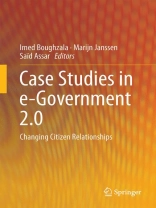The goal of this book is to provide a comprehensive, multi-dimensional approach to research and practice in e-government 2.0 implementation. Contributions from an international panel of experts apply a variety of methodological approaches and illustrative case studies to present state-of-the-art analysis and perspectives.
Around the world, governments are employing technological advancements to revolutionize their ways of working, resulting in changing relationships among public organizations and their constituents. Important enablers are new uses of information and knowledge-sharing technologies that emerged with the advent of the Web 2.0 paradigm; initially used in the private arena, such user-friendly, participatory, intuitive and flexible Web 2.0 technologies (e.g., blogs, Wikis, RSS, social networking platforms, folksonomy, podcasting, mashups, virtual worlds, open linked data, etc.) are increasingly disseminated within the professional sphere, regardless of organization type or field of activities.
Current e-government environments have undergone considerable transformations in an attempt to satisfy the incessant demand for more advanced e-service delivery, better access to information and more efficient government management. Looking to the future, the emergence of Web 2.0, the rise of social networks and the wider dissemination of data and information are expected to generate many benefits, such as a better match between public services and citizens’ expectations, greater adoption of online services by citizens and better control of costs and prevention of delays in the implementation of new services. Governments around the world are building frameworks and proposals for e-government 2.0, in the hopes of improving participation, transparency and integration, while speeding up the pace of innovation through collaboration and consultation.
This volume addresses a gap in the research literature, offering timely insights on the e-government 2.0 phenomenon and directions for future practice and policy.Inhoudsopgave
Preface.- Ch 1 E-Government 2.0: Back to Reality.- Ch 2 Social Media-Based Government Explained.- Ch 3 Moving toward Web 2.0-enhanced e-government in small-town Pennsylvania.- Ch 4 Government 2.0: A Change towards citizen Participation in Arab Countries.- Ch 5 Citizen-Driven Design.- Ch 6 In the quest of opened-up governmental policies in Greece.- Ch 7 Towards the Understanding of Success in E-Participatory Budgeting Projects.- Ch 8 Brazil Towards Government 2.0.- Ch 9 Twitter and 2013 Pakistan General Election.- Ch 10 The Decalogue of Policy Making 2.0. – Ch 11 A Community-Driven Open Data Lifecycle Model Based on Literature and Practice.- Ch 12 Social Web Ontology for Public Services.












